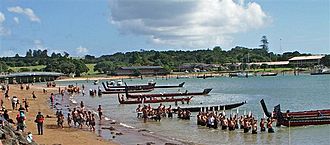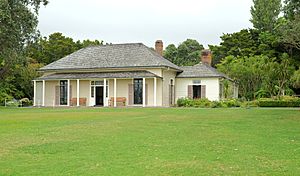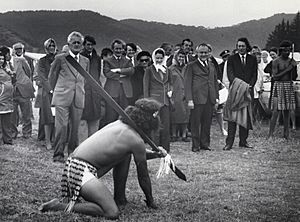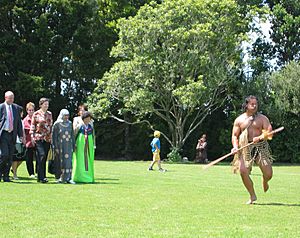Waitangi Day facts for kids
Quick facts for kids Waitangi Day |
|
|---|---|

Traditional celebrations at Waitangi
|
|
| Observed by | New Zealanders |
| Type | National |
| Significance | Commemorates the signing of the Treaty of Waitangi, regarded as the nation's founding document |
| Observances |
|
| Date | 6 February |
| Frequency | Annual |
| First time | 1934 |
Waitangi Day (Māori: Te Rā o Waitangi) is the national day of New Zealand. It celebrates the anniversary of the first signing of the Treaty of Waitangi. This important document was signed on 6 February 1840. Many people see it as the paper that helped create the nation of New Zealand.
The first Waitangi Day was celebrated in 1934. It became a national public holiday in 1974. Today, New Zealanders observe this day every year on 6 February. If the day falls on a weekend, the public holiday moves to the following Monday.
People hold ceremonies at Waitangi and other places. These events remember the signing of the treaty. There are also parties, Māori hui (gatherings), and talks about New Zealand's past. Official awards and citizenship ceremonies also take place. Sometimes, the day is also a time for Māori activists to share their concerns.
Contents
History of Waitangi Day

The Treaty of Waitangi was first signed on 6 February 1840. This happened at James Busby's house in Waitangi. This house is now called the Treaty House. The treaty was signed by people representing the British Crown. About 45 Māori chiefs also signed it at first.
Over the next seven months, copies of the treaty traveled around the country. This allowed more chiefs to sign. The signing helped Britain gain control over the islands of New Zealand. This was officially announced on 21 May 1840.
Early Celebrations
Before 1934, New Zealand's founding as a colony was often celebrated on 29 January. This was the day William Hobson arrived in the Bay of Islands. He came to announce his appointment as governor. He did not have a draft treaty with him. From the British side, his announcement was seen as the main legal document.
In 1932, Governor-General Lord Bledisloe and his wife bought James Busby's old house. They gave it to the nation. They also gave money to fix up the building. The Treaty House and its land became a public park. It was officially opened on 6 February 1934. This is seen as the very first Waitangi Day celebration.
In 1940, another big event was held at the grounds. This marked 100 years since the treaty was signed. This event was very successful. It helped more people learn about the treaty and its special day.
Yearly Events Begin
Yearly celebrations of the treaty signing started in 1947. The first event was a Royal New Zealand Navy ceremony. It focused on a flagpole the Navy had put up. This ceremony was short and did not include any Māori people. The next year, a Māori speaker was added. More parts were added almost every year after that.
From 1952, the governor-general attended. From 1958, the prime minister also started attending, though not every year. By the mid-1950s, a Māori cultural performance was usually part of the ceremony. Many of these early traditions are still part of Waitangi Day today. These include a naval salute, a Māori cultural performance (often a pōwhiri, a welcome ceremony), and speeches.
Becoming a Public Holiday
Waitangi Day became a public holiday across New Zealand in 1974. First, its name was changed. In 1971, Matiu Rata, a Labour politician, tried to make Waitangi Day a national holiday. He wanted to call it New Zealand Day. This idea did not become law at that time.
After the 1972 election, Norman Kirk became Prime Minister. His government announced that from 1974, Waitangi Day would be a national holiday. It would be known as New Zealand Day. The New Zealand Day Act was passed in 1973. Kirk believed New Zealand was ready for a wider idea of nationhood. The country was playing a bigger role in the world. So, it made sense for its national day to be called New Zealand Day.
At the 1974 celebrations, the Flag of New Zealand was flown at Waitangi for the first time. Before this, the Union Flag was flown. A copy of the flag of the United Tribes of New Zealand was also flown.
In 1975, Robert Muldoon became the new prime minister. His government changed the day's name back to Waitangi Day. Muldoon did not like "New Zealand Day." Many Māori also felt that "New Zealand Day" lessened the importance of the treaty. So, another Waitangi Day Act was passed in 1976. This changed the name back to Waitangi Day.
In 2013, a law was passed to 'Mondayise' Waitangi Day. This means if 6 February falls on a Saturday or Sunday, the public holiday moves to the following Monday.
How Waitangi Day is Celebrated
At Waitangi

Celebrations at Waitangi often start on 5 February. This is at the Te Tii marae (meeting ground) of the Ngāpuhi people. Important politicians are welcomed onto the marae. They listen to speeches from the local iwi (tribe). These speeches often talk about current issues. There can be strong debates. Politicians usually get to speak. But sometimes, this right has been taken away. This happened to Prime Minister John Key in 2016 and Bill English in 2017. In 2018, Jacinda Ardern was the first Prime Minister to attend in three years.
At dawn on Waitangi Day, the Royal New Zealand Navy raises flags. They raise the New Zealand Flag, the Union Flag, and the White Ensign. These flags are on the flagstaff at the treaty grounds. The day's ceremonies usually include a church service. There are also cultural shows with dance and song. Several waka (Māori canoes) and a navy ship re-enact Governor Hobson arriving to sign the treaty. The day ends with the Navy lowering the flags in a special ceremony.
Elsewhere in New Zealand

Some marae open their doors on Waitangi Day. They offer an educational experience for their local communities. People can learn about Māori culture and customs. They can also hear about the future for Māori in New Zealand.
Compared to other countries' national days, celebrations are often quieter. There are no big parades or fireworks displays. At Government House in Auckland, citizenship ceremonies are often held. Since it is a public holiday and warm in New Zealand, many people go to the beach. This is a popular part of New Zealand culture.
Since 2014, the New Zealand Society of Authors gives out the NZSA Waitangi Day Literary Honours on this day.
In Australia
In Kingston, Queensland, Australia, a multicultural festival was held for Waitangi Day. This was organized by the Te Korowai Aroha (Cloak of Love) Association. In Sydney, thousands of people attend the Waitangi Day Festival. This event has displays of Māori items, haka performances, and Māori food. It also features tattooing and wood carving. Since 2015, a Waitangi Day Commemoration is held at Nurragingy Reserve. This event focuses more on the treaty itself and its meaning today.
In the United Kingdom
In London, England, many New Zealanders live there. They celebrate with the Waitangi Day Ball. This event is held by the New Zealand Society UK. It focuses on New Zealand's unity and different cultures. The Ball also hosts awards for the UK New Zealander of the Year. There is cultural entertainment from a London-based Māori group, Ngāti Rānana. Fine New Zealand food and wine are also served. A church service is also held by the society.
Around the World
In many other countries, New Zealanders celebrate Waitangi Day privately. New Zealand embassies and high commissions officially mark the day.
For Waitangi Day 2007, Air New Zealand asked New Zealanders in Los Angeles to create a sand sculpture. They made a silver fern on Santa Monica Beach. This caused a lot of interest in the area.
See also
 In Spanish: Día de Waitangi para niños
In Spanish: Día de Waitangi para niños


